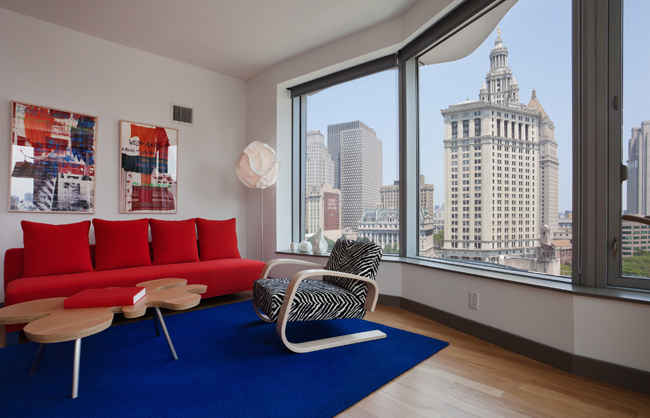8 Spruce Street
Making waves in the skyline: Frank Gehry drapes his first skyscraper in rippling stainless steel, bringing luxury living to lower Manhattan












Architects & Firms
New York City, NY.
One survived and one didn’t,” says Frank Gehry, referring to two of his New York City projects commissioned by developer Bruce Ratner. The one that didn’t was Gehry’s master plan for Atlantic Yards, the controversial mixed-use development on 22 acres in Brooklyn, which included an arena to house the New Jersey Nets. Gehry’s design was dropped in 2009 due to its high cost. An Ellerbe Becket and SHoP–designed arena is currently the only building under construction there.
The one that survived has thrived, asserting itself on Manhattan’s southern skyline. The 76-story, 870-foot-tall luxury residential tower ' officially named New York by Gehry at 8 Spruce Street ' holds the title for New York City's tallest residential tower and is Gehry's first skyscraper. Its stainless steel facade ripples like laundry caught in the breeze, except for one smooth facade. A public school, which Gehry clad in staid brick, occupies a five-story podium. (Swanke Hayden Connell did the interior fit-out.)
From some units one can see the 1913 Woolworth Building. “What pleases me is that I don’t preempt the Woolworth building,” says Gehry. “We stand side by side and talk to each other. Usually [New York City] buildings are just neo-historic. Up close they fall apart.”
Bay windows in a two-bedroom unit on the ninth floor frame views of the handle-barred arteries that feed the Brooklyn Bridge. This 1,100-square-foot apartment also happens to be the “Frank unit.” The architect designed many of the furnishings – Hat Trick chairs, a Cloud Lamp, and custom furniture in Douglas fir – and handpicked others, such as an Alvar Aalto chair upholstered in a zebra print. In all other apartments, Gehry selected finishes and fixtures. He designed the lobby’s undulating Douglas-fir concierge desk and other built-in elements. Because the irregular facade resulted in over 200 unique floor plans, 20 model apartments are being shown to prospective renters. Gehry Partners selected the furniture and lighting for these.
Still, the building shares its biggest move – the facade – with the city. The interior layouts of the poured-in-place concrete structure are status quo by contrast. The market dictated their dimensions. “People are used to a way of living,” says Gehry. In order to make the building “special,” he added bay windows on every floor. “I started moving them, and I realized I got the freedom of the folds I was looking for.” Gehry dismissed the idea that his rippled approach was achieved at random. It comes from a career-long study of theemotion of movement, he says – Greek sculpture, Michelangelo, Bernini, and dancing Shiva figures. “The fold is very primitive,” says Gehry. “Fabric resonates with people.”
And something about the stepped-back tower is resonating with New Yorkers. As of early August, more than 400 of the 903 units had rented since leasing began in February, according to Gehry’s office. Moving to the financial district is on the rise: Census figures show that about 82,000 people live south of Canal Street, a 43 percent increase from 2000. Amenities could also be a draw – 22,000 square feet of indoor/outdoor health club and entertainment space and the 50-foot pool. Finally, “New York by Gehry,” another moniker, may be irresistible packaging.
The architect claims that his complicated facades didn’t cost Ratner any more than the flat southern facade. “The premium here was zero,” he says. “If people choose not to make a building with character, it’s because they don’t feel like it.”
Size: 1.1 million square feet
Cost: $875 million (development)
Completion date: Opened for rentals, Spring 2011; expected full completion, Summer 2012
PeopleClient: Forest City Ratner Companies
Architect:
Personnel in architect's firm who should receive special credit: Structural: WSP Cantor Seinuk M/E/P: Jaros Baum & Bolles Consulting Engineers
Consultants: |
ProductsBuilding envelope: Permasteelisa, steel panels and glazing Flooring: Armstrong, Bruce Custom furniture: PGS Millwork, Tomas Osinski Design |









